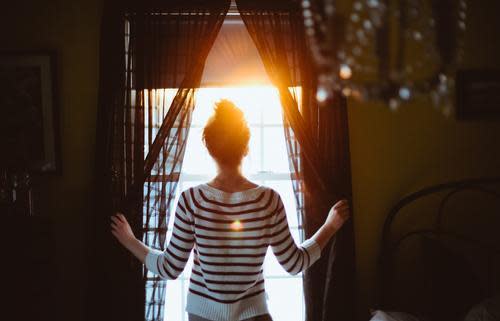How To Make Daylight Saving Time Suck Less

Waking up an hour earlier is no fun for anyone — but you can make it less painful with these sleep expert-approved tips. (Photo: Stocksy/Joe St.Pierre Photography)
Winston Churchill once described Daylight Saving Time as “an extra yawn some morning in April, an extra snooze some morning in September.”
Churchill is partly correct. Setting the clocks forward one hour for Daylight Saving Time results in an average of 30 to 40 minutes less sleep, according to studies using data from the American Time Use Survey.
But in other ways — and for certain people, such as night owls — the effects can be much more difficult than Churchill suggests. In one study of German adults, life satisfaction and mood were significantly lower after the transition to summer time. One study of adolescents published in Sleep Medicine found that daytime sleepiness can last for about three weeks after the time shift, and that night owls reported higher sleepiness scores than larks.
The key to make the transition as quick and painless as possible, says sleep expert W. Christopher Winter, MD, is to force yourself to get up precisely at the new wake-up time on Monday morning. That is, don’t allow yourself an extra half hour of sleep or an extra-long nap because of the shift — as tempting as it may be.
Related: Is It Possible To Sleep Too Much?
In addition, Winter tells Yahoo Health, don’t worry too much about getting to bed early on Sunday night. Just go to bed when you feel tired. “Where people start to get screwed up is that they go to bed at 10, at 10:30 they’re still wide awake and anxious, and then it takes them much longer to go to bed than normal,” he says. This can start a spiral of anxiety and trying to catch up on lost sleep that throws off your sleep schedule considerably more than the one-hour time change. “When people tell you that it takes weeks and weeks to adjust to Daylight Saving, that’s normally what they’re talking about,” Winter explains.
As you can probably notice come Monday morning simply by looking around at your coworkers, some people adjust to the time shift more easily than others, according to a 2013 research review. Research shows that people who typically keep a strict regular sleep schedule and those who have a hard time fighting fatigue take a longer time to adjust to DST. And people who typically don’t get as much sleep as they’d like are especially likely to report sleep difficulties related to the spring DST change.
Not surprisingly, night owls are also more susceptible to sleep problems than morning people, according to research published in BMC Physiology.
If you’re anxious about the Daylight Saving Time change, Winter says, the best thing you can do is keep a consistent wake-up time. “We focus a lot on the bedtime in our society. We really need to pay more attention to the wake time,” he explains. “Once the wake time is set, truly set, bedtime tends to follow on its own — and with it, confidence and less worry about sleep.” In other words, even if you feel groggy, haul yourself out of bed Monday morning — and remind yourself that even if it feels terrible now, it’s worth it to help adjust your sleep schedule faster.
Another simple strategy to help your body with the change: Eat meals at your normal time, even if you aren’t hungry yet. “Our bodies learn to expect foods at certain times during the day, which can be called ‘the food clock,’” Abigail Douglas, RD, LD, clinical dietitian with the University of Kansas Hospital, tells Yahoo Health. “If you are able to keep eating patterns and daily habits the same, just shifted by one hour to adjust for the time change, your body will quickly adjust to DST.”
Related: Hot Breakfasts You Can Make In 5 Minutes
Exposure to light is an even more powerful bodily time cue, Winter says. “Going outside is best, but a lot of times when you’re getting up this time of year it’s still very dark,” he says. So enlist artificial light to help with the transition. The light needs to be full-spectrum or in the blue-green range, Winter says. He suggests using the Re-Timer goggles, which allow you to walk around the house as they deliver light to your eyes, or a light box specially designed for light therapy.
If those options are too pricey, look for the brightest full-spectrum light bulbs you can find and install them where you typically hang out in the morning (the bathroom, kitchen, or your home office, for example).
And if you can, hit the gym in the morning. Not only do gyms typically have very bright lighting, but physical activity can also help wake you up, Winter says.
“Get up, eat breakfast even if you’re not that hungry for it, expose yourself to light, get some exercise — you’ll adjust in no time,” Winter says.
Up Next: What To Eat (And What To Avoid) For Better Mental Clarity
